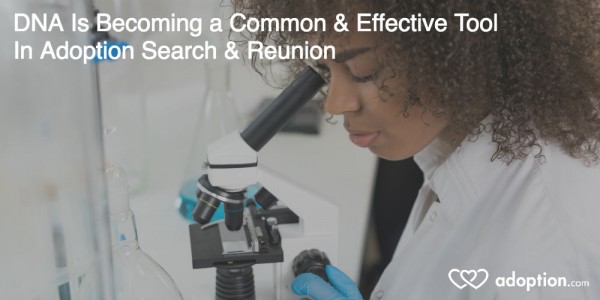Every day, more and more adoptees are using DNA as a tool to find birth families. Three types of testing available may help. You can do a mitochondrial test for your direct maternal line, a Y-line for your direct paternal line (for males only), and an autosomal to reveal ethnic mix and find cousin matches. There are a few major companies that do DNA testing. Most adoptees use autosomal testing with good results. 23andMe does all three tests. Their company is known for its specificity and medical information. Even if you are not looking to connect with family, adoptees can benefit from the medical aspect. The results are not diagnostic, but they do show genetic markers for certain health risks. Ancestry DNA is believed to have the largest database for establishing matches. Whatever you choose, DNA as a tool is a great resource.
There is some healthy debate over which company to test with and where to transfer results to. Different people will have different preferences for using DNA as a tool. If you can afford it, take all the tests. You will end up with the most information and the best possible matches. For many people, that is not an option. From all of the adoption circles, I’m part of, it is widely believed that the best course of action for an adoptee is to take the Ancestry DNA test, and then upload the raw data to GEDmatch. GEDmatch accepts DNA from three leading testing sites, so doing so can result in more matches. It is a free service mainly focused on genealogy. This is the most cost-efficient, and you can always take a different test later if you aren’t happy with your results.
Before you test, there are things you can be doing to further your search. Check your state laws to see if you have access to your original birth certificate. A handful of states have changed their laws so adoptees can obtain their birth information. If you live in one of those states, you may not need to go any further. Next, put your info on all the top adoption registries. You’ll want to use the Reunion Registry and your state’s adoption registry. Then, you need to get your non-identifying information, if you don’t have it already, from the agency or state who handled your adoption. Non-id info will include general information about your parents and sometimes your grandparents. There should be a physical description, approximate age, educational background, etc.
Up until about two years ago, I thought that to find someone using DNA, that specific person had to have tested. Thankfully, that isn’t the case. Once you submit the test, it takes several weeks to process. When your test is finished, you will receive a list of matches. You want to look at close cousin matches, usually first and second cousin. The test measures how many centimorgans you share with someone per number of DNA segments. Based on that, the test predicts a relationship. While it is possible to have a parent/child match right out of the gate, that is usually not the case. You will need to explore the public family trees of your closest matches. You can compare your non-id info with the people on those trees that fit into the time frame around your birth. You can use birth and death records, as well as property records and background checks, to fill in your family tree and provide contact info for relatives. Even if your matches are more distant, you still may have the info you need.
If you have to contact one of your matches for further information, tread lightly. I suggest taking screenshots of their trees beforehand. I would not mention adoption if it can be avoided. Family secrets abound in genealogy research, so people tend to clam up when they hear the word adoption. Your goal is to get all the info you can from them, without scaring them off.
Sometimes it takes a lot of time and patience to methodically work through all the information. If you find yourself overwhelmed, take a break, and clear your head. If you need help, seek it out. There are websites and Facebook pages dedicated to adoptees and DNA results. The people there can help you. If your matches aren’t as good as you had hoped, don’t get discouraged. New people are testing every day. Keep watching for new matches. I’ve heard plenty of stories where people who had tested months earlier found a new match in their email that turned out to be their parents.
Once you have narrowed the information to the person you are looking for, take things slow. A person’s life may be completely different. Other families may not know about you. Emotions will run high. If for some reason initial contact doesn’t go as planned, give it time. People usually do best when they have time to process their emotions. I have never heard anyone say they regretted taking the DNA test. Even in cases with failed reunions, most are grateful to know the truth.
For more information on DNA as a tool and reunions as well as other methods of finding your birth parents, check out these new adoption classes.

